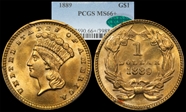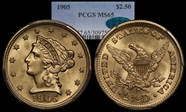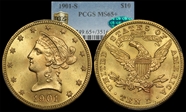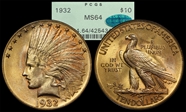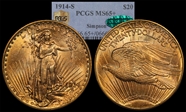orifdoc's Type Gold 的钱币相册
The little Type I gold dollar is the nation's smallest coin. At a whopping 13mm in diameter, this series would not be a good choice for the visually-impaired. This example sports really nice detail and luster. The obverse would command a gem designation but is held back by the slightly weaker reverse.
The type 2 gold dollar is an interesting but short-lived issue. I quite like the design, but almost all examples show central strike weakness. This example is a little better than average in this respect. It has has a nice, old patina and lively luster. Unlike many others, there are no clash marks. Some superficial, but not especially distracting stray marks account for the grade.
Gold dollars are either your thing or they aren't. I find them fascinating and little jewels like this one are miniature works of art, far exceeding their intended purpose of instrument of commerce. This type 3 example is a wonderfully original specimen from the final year of mintage. Luster is brilliant and cascading. Detail is excellent and the coin has a rich, orange coloration.
Nice luster, solid strike, and clean surfaces combine to create a beautiful gem.
Along with the half-eagle, the incuse design of the Indian Quarter Eagle creates a memorable impression. This near-gem example shows sharp detail and nice luster.
From Russ Augustin. One of my favorite pieces. Exquisite for grade with ample luster and no distracting marks.
The Liberty Half Eagle is a coin that spans an incredible range of dates. This 20th Century example sports really nice surfaces and deep, rich luster. It looks as nice as the day it was made.
The iconic Bela Pratt design is an American classic, and the incuse design represents a significant departure from tradition. This example demonstrates full detail and cascading luster over both the raised fields and devices. Only a few upper-right reverse field marks keep it from full gem status.
The 1901-S is the most common Liberty Eagle. Most likely, this example spent some time lounging around in Swiss bank vaults. The majority of the 200,000 or so extant examples are uncirculated, but most are in the range of MS62-MS64. They become more scarce at gem grades. This example has a rich, original patina, a touch of copper showing below the arrows in the left claw of the eagle, and really nice detail. Luster is deep and just a few light ticks keep it out of a 66 holder.
Liberty Double Eagles are impressive coins which represented an enormous store of value when produced. This common-date example demonstrates booming luster and no significant distractions. It's a true gem in every way.
This coin is just outstanding with rich color and deep luster. The surfaces demonstrate a flashy, pebbly surface that has the feel of old, original gold. The coin was part of the Crawford Collection and eventually made its way to the Simpson collection. It eventually made its way to RYK and I was lucky enough to acquire it from Doug Winter when he sold the bulk of his collection.






















